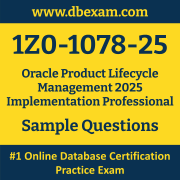01. Identify two entities where you can define only Descriptive Flexfield segments but not Extensible Flexfields.
a) Items
b) Item Cross Reference
c) Item Revision
d) Item Supplier Site
e) Item Catalogs
02. Your customer wants a For Your Information (FYI) notification to be sent to approvers when a change order workflow is completed.
Which configuration setup on the Notifications page of ChangeOrderApprovalTask will enable this requirement?
a) Task Status = Outcome Update, Recipient = Assignees
b) Task Status = Complete, Recipient = Assignees
c) Task Status = Complete, Recipient = Reviewers
d) Task Status = Alert, Recipient = Reviewers
e) Task Status = Complete, Recipient = Owner
03. Which three trading partner types are valid for creating trading partner item relationships in Oracle Product Hub Cloud?
a) Competitor
b) Supplier Site
c) GS1
d) Customer
e) Manufacturer
04. How do you enable or set up Audit Trail for Product Data Hub object attribute?
a) No enabling required, Audit Trail is automatically enabled in Product Data Hub.
b) Using Setup and Maintenance, search for Manage Audit Trail task, Select Oracle Cloud Application, Configure Business Object Attributes for Product Management application
c) From Product Hub Main page, select Task Icon, Audit Trail, Configure Business Object Attributes for Product Management application
d) Using Setup and Maintenance, search for Manage Audit Policies task, Select Oracle Cloud Application, Configure Business Object Attributes for Product Management application
e) From Main Navigator, Choose Audit Trail, Oracle Cloud Application, Configure Business Object Attributes for Product Management application
05. Which statement is true about publishing items in Oracle Product Hub Cloud?
a) All newly created items are published, irrespective of the Publication Criteria.
b) All items that meet the last Publication Date or Criteria Date, irrespective of the Publication Criteria, are published.
c) All items that meet the last Publication Date or Criteria Date and the Publication Criteria are published.
d) All items that meet the Publication Criteria, irrespective of the last Publication Date or Criteria Date, are published.
06. Your customer wants to add a new supplier to Oracle Product Hub Cloud. What steps must you complete in order to do so?
a) Create Supplier, Create Address, Create Site, Create Site Assignments, Create Suppliers Site Contact
b) Create Supplier, Create Site, Create Site Assignments, Create Address, Create Suppliers Site Contact
c) Create Address, Create Supplier, Create Site Assignments, Create Site, Create Suppliers Site Contact
d) Create Address, Create Supplier, Create Site, Create Site Assignments, Create Suppliers Site Contact
e) Create Supplier, Create Address, Create Site Assignments, Create Site, Create Suppliers Site Contact
07. When item metadata publish is enabled for an item class in Oracle Product Hub Cloud, which entities are included in the published payload during the first publish?
a) item profile options definition, value set definition, and Item Operational attributes definition
b) value set definition, associated transactional item attributes, and item Operational attributes definition
c) item class definition, associated attribute groups and attributes, and associated transactional item attributes.
d) associated attribute groups and attributes, associated transactional item attributes, and Item Operational attributes definition
e) value set definition, associated attribute groups and attributes, and associated transactional item attributes
08. A buyer has requested Product Data Steward to create a laptop item with structure in Product Hub. Product Data Steward is unable to define the structure. Why?
a) The Product Development option under Product Management offering is not provisioned.
b) The Item and Catalog Management and Structures functional areas are not enabled.
c) The Product Management offering is not provisioned and Define Product Source System feature is not enabled.
d) The Define Data Quality for Products feature is not provisioned.
09. What are the three options that you select in Oracle Product Hub Cloud to publish objects to a spoke system?
a) Item Classes
b) Item Relationships
c) Item Cross Reference
d) Items
e) Item Catalogs
10. Choose the two different input file types that Product Hub supports for Import Maps.
a) HTML
b) Excel
c) PDF
d) XML
e) Text
 The Oracle Product Lifecycle Management Implementation Professional (1Z0-1078-25) Sample Question Set is designed to help you prepare for the Oracle Product Lifecycle Management 2025 Certified Implementation Professional certification exam. To become familiar with the actual Oracle Certification exam environment, we suggest you try our Sample Oracle 1Z0-1078-25 Certification Practice Exam.
The Oracle Product Lifecycle Management Implementation Professional (1Z0-1078-25) Sample Question Set is designed to help you prepare for the Oracle Product Lifecycle Management 2025 Certified Implementation Professional certification exam. To become familiar with the actual Oracle Certification exam environment, we suggest you try our Sample Oracle 1Z0-1078-25 Certification Practice Exam.